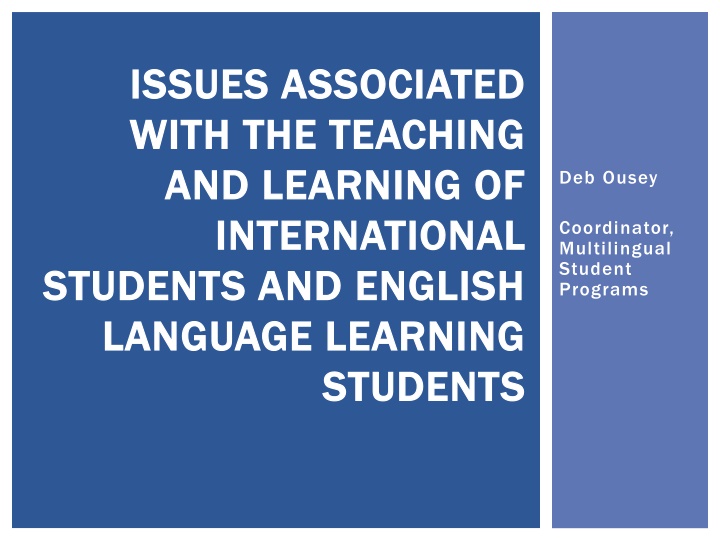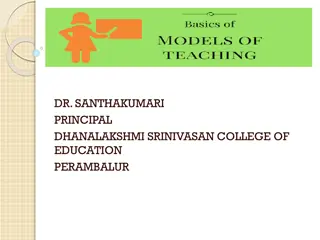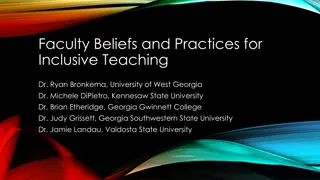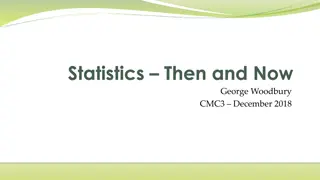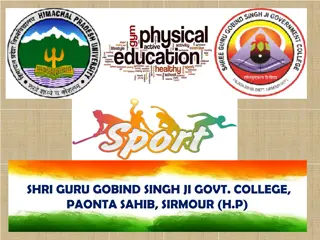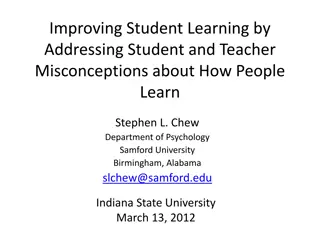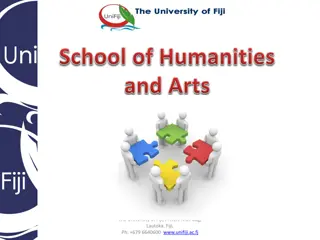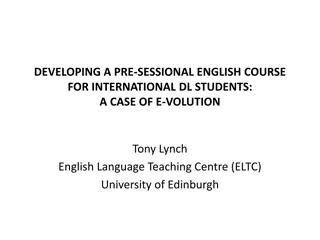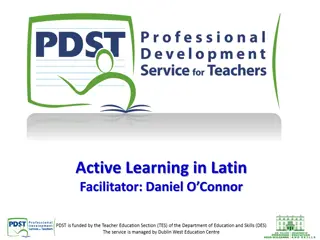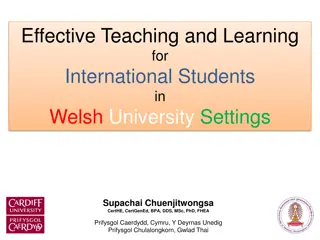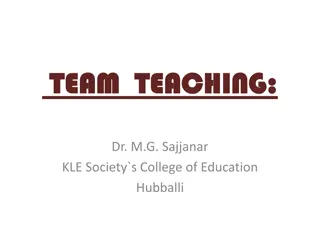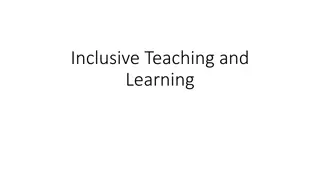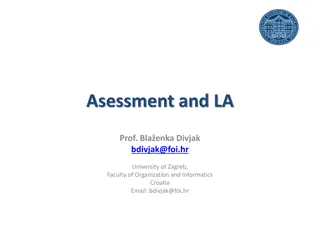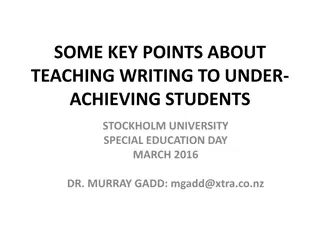Challenges in Teaching and Learning International Students
Issues associated with the teaching and learning of international students and English language learning, including misconceptions about ESL and ELL, the importance of using positive terminology, the different types of multilingual students, and statistics on international students in higher education.
Download Presentation

Please find below an Image/Link to download the presentation.
The content on the website is provided AS IS for your information and personal use only. It may not be sold, licensed, or shared on other websites without obtaining consent from the author.If you encounter any issues during the download, it is possible that the publisher has removed the file from their server.
You are allowed to download the files provided on this website for personal or commercial use, subject to the condition that they are used lawfully. All files are the property of their respective owners.
The content on the website is provided AS IS for your information and personal use only. It may not be sold, licensed, or shared on other websites without obtaining consent from the author.
E N D
Presentation Transcript
ISSUES ASSOCIATED ISSUES ASSOCIATED WITH THE TEACHING WITH THE TEACHING AND LEARNING OF AND LEARNING OF INTERNATIONAL INTERNATIONAL STUDENTS AND ENGLISH STUDENTS AND ENGLISH LANGUAGE LEARNING LANGUAGE LEARNING Deb Ousey Coordinator, Multilingual Student Programs STUDENTS STUDENTS
SO MANY TERMS! ESL (English as a Second Language) Often a misnomer, as many students speak 3+ languages Often seen by students (and faculty) as a remedial or deficit label ELL (English Language Learner) Used more often in K-12 settings College students may often see this label as meaning something is lacking
MORE POSITIVE TERMINOLOGY Multilingual Students Multiple language backgrounds seen as a strength
TYPES OF MULTILINGUAL STUDENTS International students F-1 (student) visa Here to study (not immigrant) Usually plan to live in native country after graduation Growing population in U.S. higher education Many Chinese students are parachute kids in high school dropped off at American high schools (boarding or with host family) for a better chance to get into a U.S. college
INTERNATIONAL STUDENTS IN HIGHER EDUCATION (2014-15) Source: Institute of International Education (IIE), 2015 Fast Facts, Open Doors Report on International Educational Exchange (Washington, DC: IIE, 2015
International Students by Location, Fall International Students by Location, Fall 2015 2015 Fall 2015 LOCATION LOCATION UNDERGRADUATE UNDERGRADUATE GRADUATE GRADUATE LAW LAW MEDICINE MEDICINE TOTAL TOTAL PENN STATE ABINGTON 168 168 PENN STATE ALTOONA 171 171 PENN STATE BEAVER 21 21 PENN STATE BERKS 81 81 PENN STATE BRANDYWINE 19 19 PENN STATE DICKINSON (CARLISLE) 6 6 PENN STATE DUBOIS 2 2 PENN STATE ERIE 355 1 356 PENN STATE FAYETTE 11 11 PENN STATE GREAT VALLEY 63 63 PENN STATE GREATER ALLEGHENY 22 22 PENN STATE HARRISBURG 387 107 494 PENN STATE HAZLETON 12 12 PENN STATE HERSHEY, COLLEGE OF MEDICINE 53 14 67 PENN STATE LEHIGH VALLEY 2 2 PENN STATE MONT ALTO 3 3 PENN STATE NEW KENSINGTON 11 11 PENN STATE SCHUYLKILL 9 9 PENN STATE UNIVERSITY PARK 4382 2575 124 7081 PENN STATE WILKES BARRE 2 2 PENN STATE ORTHINGTON SCRANTON 3 3 PENN STATE YORK 145 145 EDUCATION ABROAD 9 9 Grand Total 5815 2799 130 14 8758
INTERNATIONAL STUDENTS AT BRANDYWINE 15 this year, 16 last year, more next year with dorms??? From China (8), India (3), South Korea (1), Russia (1), Kenya (1), Angola (1)
U.S.-EDUCATED MULTILINGUAL STUDENTS Have had at least part of their K-12 schooling in the U.S. Students who have immigrated to the U.S. with their families OR who were born in the U.S. but speak a different language at home or live in a neighborhood where they have little need to speak English outside of school
Spanish 11 AT BRANDYWINE FALL 2016 Chinese 8 Bangla 5 Hindi 5 Gugrati 3 Punjabi 3 17% of the freshman class reported that the primary language at home is NOT English (52 students) Russian 3 Urdu 3 Italian 2 Amharic 1 Arabic 1 Falam 1 Greek 1 22 different languages were reported (by incoming freshmen) as the primary language at home Krio 1 Malayalam 1 Mandingo 1 Polish 1 Portuguese 1 Tagalog 1 Telugu 1 Tigrinya 1 Vietnamese 1
POSSIBLE CHALLENGES PRACTICAL ISSUES READING COMPREHENSION CONTENT/ORGANIZATION IN WRITING WORKING WITH SOURCES GRAMMAR/LANGUAGE ISSUES CLASSROOM PARTICIPATION/CULTURAL ETIQUETTE CAMPUS INTEGRATION
INTERNATIONAL STUDENT PRACTICAL ISSUES Visa Compliance Need to submit documents online Need to have travel signature to travel outside U.S. Need to earn at least 12 credits each semester Can take a maximum of 3 online credits per semester Can only work ON CAMPUS (NOT work-study) and only after doing proper paperwork Can work off-campus as an INTERNSHIP IF taking an internship class or independent study (paperwork!)
INTERNATIONAL STUDENT PRACTICAL ISSUES MORE PAPERWORK Driver s license Often involves driving school Need a letter from Social Security Office saying not eligible for a SS# Financial guarantee Social Security Number Proof of approved insurance Housing, bills, etc. PUBLIC TRANSPORTATION
INTERNATIONAL STUDENT PRACTICAL ISSUES You CAN hire an international student on campus (NOT work study) A little more paperwork for THEM after you decide to hire them International students CAN usually go on the study abroad trips However, may need to apply for a visa based on their passport This may take extra time
U.S.-EDUCATED MULTILINGUAL STUDENT PRACTICAL ISSUES Often are the TRANSLATORS for the parents and grandparents Paying bills Going to doctor appointments with family members Completing legal documents FAMILY is most important May be expected to care for a sick younger sibling instead of going to class May be expected to work in the family business
U.S.-EDUCATED MULTILINGUAL STUDENT PRACTICAL ISSUES May lack U.S. cultural knowledge or experience Field trips Holidays U.S. travel May live one culture at home and another at school
U.S.-EDUCATED MULTILINGUAL STUDENT PRACTICAL ISSUES May be the first in the family to enroll in higher education in the U.S. May have family expectations of a career in medicine, engineering or business (despite own interests or strengths) PUBLIC TRANSPORTATION
READING COMPREHENSION READING COMPREHENSION POSSIBLE CHALLENGES academic reading in English limited experience reading longer texts in English lack of understanding of common sports, religious and cultural references and antiquated language Time-consuming
READING COMPREHENSION READING COMPREHENSION POSSIBLE SUGGESTIONS taking notes while reading discussing and writing reflections on readings gauging reading comprehension before moving to other issues (e.g. in a research paper) allowing plenty of time for assignment
CONTENT/ORGANIZATION IN WRITING CONTENT/ORGANIZATION IN WRITING POSSIBLE CHALLENGES sometimes so focused on grammar that neglects other writing issues lack of familiarity with American college essay conventions lack of experience writing own thoughts and opinions time-consuming
CONTENT/ORGANIZATION IN WRITING CONTENT/ORGANIZATION IN WRITING POSSIBLE SUGGESTIONS explicitly teach writing structure and expectations provide/discuss samples of strong writing teach/encourage use of graphic organizers create several due dates for different stages of the writing assignment discuss students individual writing processes in class allow students to talk out their papers while the listener takes notes (or do elevator speech ) address content and organization before grammar provide many opportunities to express and support own ideas
WORKING WITH SOURCES WORKING WITH SOURCES POSSIBLE CHALLENGES may have never incorporated sources in writing may never had had to cite sources may come from a culture where citations are not needed may have trouble evaluating sources and evaluating the reading level of sources may struggle with the higher reading-writing demands
WORKING WITH SOURCES WORKING WITH SOURCES POSSIBLE SUGGESTIONS provide topic choices (background knowledge/interests) encourage/require multiple drafts require an annotated bibliography before writing begins discuss the American idea of intellectual property explicitly model how to cite sources and provide explicit practice scaffold background reading understand that citation skills develop on a continuum require an appointment with a librarian English-language sources
GRAMMAR/LANGUAGE ISSUES GRAMMAR/LANGUAGE ISSUES POSSIBLE CHALLENGES may not understand register (overly formal or informal expressions) may directly translate their thinking in their native language into English may not be able to read cursive may have difficulty with transitional words may write what they hear
GRAMMAR/LANGUAGE ISSUES GRAMMAR/LANGUAGE ISSUES POSSIBLE SUGGESTIONS Identify types of grammatical errors in easy to understand English or use coded comments that have been explained encourage use of native language for a particular word to keep the flow of writing in a draft but discourage longer translations focus on a limited number of global errors in writing encourage writing tutoring address other writing issues before grammar print (don t use cursive) introduce the student to me (!)
CLASSROOM PARTICIPATION CLASSROOM PARTICIPATION/ / CULTURAL CULTURAL ETIQUETTE ETIQUETTE POSSIBLE CHALLENGES may be uncomfortable taking direction from or shaking hands with person of opposite gender may have difficulty expressing disagreement with authority figure or expressing own opinion may smile and express agreement even if comprehension is lacking may be very uncomfortable discussing/writing/reading about some topics (such as sexuality, religion, government) may need more time to formulate a response may wish to form groups entirely of students from their native country may not offer opinions during group work
CLASSROOM PARTICIPATION CLASSROOM PARTICIPATION/ / CULTURAL CULTURAL ETIQUETTE ETIQUETTE POSSIBLE SUGGESTIONS learn about/ask about students culture without first stating assumptions that may not be true don t make student cultural expert of whole country allow more wait time after asking questions or have students write responses before calling on them have an exit ticket where each student must write a question or something learned that day assign students to groups assign and teach roles for group work learn to pronounce student names learn students preferred names
CAMPUS INTEGRATION CAMPUS INTEGRATION POSSIBLE CHALLENGES may be reluctant to join clubs or attend out-of-class events may only socialize with students of same background
CAMPUS INTEGRATION CAMPUS INTEGRATION POSSIBLE SUGGESTIONS personally invite students involve students in event planning create events where students are the experts partner with other classes mix up seating (deck of cards?)
